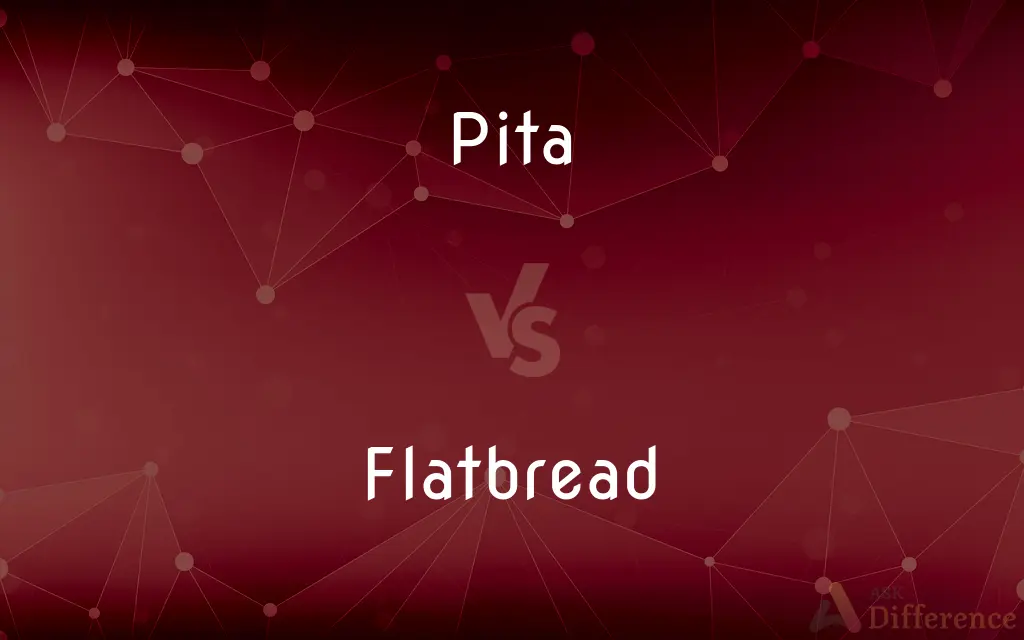Pita vs. Flatbread — What's the Difference?
By Maham Liaqat & Urooj Arif — Updated on March 27, 2024
Pita is a type of soft, slightly leavened flatbread known for its pocket, ideal for sandwiches. Flatbread, a broader category, encompasses various unleavened or leavened breads, including pita, without specific features.

Difference Between Pita and Flatbread
Table of Contents
ADVERTISEMENT
Key Differences
Pita bread is distinguished by its unique pocket feature, which results from steam puffing up the dough during baking. This pocket makes pita ideal for fillings, such as in sandwiches or as a vessel for dips and spreads. On the other hand, flatbread refers to a wide range of breads that are flat in shape and can be either leavened or unleavened. Flatbreads can include varieties such as naan, tortillas, and indeed pita, making the term much more inclusive.
The leavening process is a key differentiator; pita bread is slightly leavened, which contributes to its ability to puff up and form a pocket. Meanwhile, flatbreads can be found in both leavened forms, like naan that contains yeast or baking powder, and unleavened forms, such as tortillas. This diversity in preparation methods gives flatbreads a wide range of textures, from soft and fluffy to crisp and cracker-like.
Pita is traditionally associated with Middle Eastern, Mediterranean, and Balkan cuisines, serving as a staple food item that complements a variety of dishes. Flatbread, due to its broad definition, is a global phenomenon with each culture having its own version and method of preparation, thus reflecting a rich diversity in culinary traditions.
Culinary uses of pita often involve slicing or tearing it to create pockets for fillings or using it whole as a base for toppings. Flatbreads, given their variety, have a vast range of culinary uses, from serving as wraps or tacos in Mexican cuisine (tortillas) to being used as a spoon in Ethiopian cuisine (injera).
The preparation of pita involves mixing basic ingredients like flour, water, yeast, and salt, then baking at high temperatures to achieve the characteristic pocket. In contrast, the ingredients and preparation methods for flatbreads vary widely, with some requiring only flour and water and others incorporating milk, yogurt, or different fats to achieve the desired texture and flavor.
ADVERTISEMENT
Comparison Chart
Leavening
Slightly leavened (with yeast)
Can be leavened or unleavened
Characteristic
Has a pocket inside
Varies widely, no specific feature
Main Ingredients
Flour, water, yeast, salt
Varies (can include a wide range of ingredients)
Culinary Uses
Sandwiches, dips
Wraps, scooping curries, serving as base for toppings
Origin
Middle Eastern, Mediterranean
Global
Compare with Definitions
Pita
Soft, pocketed bread for fillings.
She filled her pita with grilled vegetables and hummus.
Flatbread
Broad category including pita.
For dinner, they made a variety of flatbreads, including pita.
Pita
Leavened Middle Eastern flatbread.
Pita is often served with falafel.
Flatbread
Can be leavened or unleavened.
Their homemade flatbread was thin and crispy, made without yeast.
Pita
Serves as a versatile culinary component.
Pita can replace utensils, used to pick up food directly.
Flatbread
Serves diverse culinary uses globally.
Flatbread accompanies many dishes around the world, from Indian naan to Mexican tortillas.
Pita
Ideal for sandwiches and dips.
Pita bread is frequently used to scoop up baba ganoush.
Flatbread
Reflects cultural culinary traditions.
Every region has its own unique flatbread recipe, from soft and fluffy to crisp and thin.
Pita
Baked at high temperatures to puff up.
The pita puffed beautifully in the oven, creating a perfect pocket.
Flatbread
Ingredients and textures vary.
The flatbread was enriched with yogurt for softness.
Pita
Pita ( or US: ) or pitta (British English), is a family of yeast-leavened round flatbreads baked from wheat flour, common in the Mediterranean, Middle East, and neighboring areas. It includes the widely known version with an interior pocket, also known as Arabic bread (Arabic: khubz ʿarabī), Syrian bread and other names, as well as pocketless versions such as the Greek pita, used to wrap souvlaki.
Flatbread
A flatbread is a bread made with flour; water, milk, yogurt, or other liquid; and salt, and then thoroughly rolled into flattened dough. Many flatbreads are unleavened, although some are leavened, such as pizza and pita bread.
Pita
A round flat bread of Middle Eastern origin that can be opened to form a pocket for filling. Also called pocket bread.
Flatbread
Any of various breads made from usually unleavened dough and baked in flat, often round loaves.
Pita
Any of several agaves that yield strong leaf fibers. Also called istle.
Flatbread
A thin, flat bread, often made from unleavened dough.
Pita
The fiber of any of these plants, used in making cordage and paper.
Flatbread
Any of various breads made from usually unleavened dough
Pita
A flat bread pouch used for making sandwiches such as gyros or falafels.
Pita
A fiber obtained from the Agave americana and related species, used for making cordage and paper.
Pita
The plant which yields the fiber.
Pita
A fiber obtained from the Agave Americana and other related species, - used for making cordage and paper. Called also pita fiber, and pita thread.
Pita
Usually small round bread that can open into a pocket for filling
Common Curiosities
What is pita bread?
Pita is a soft, slightly leavened bread known for its pocket, making it ideal for sandwiches and dips.
How does pita differ from other flatbreads?
Pita is specifically leavened and known for its pocket feature, unlike other flatbreads that may not have a pocket and can be leavened or unleavened.
Can flatbread have a pocket like pita?
While pita is specifically designed to have a pocket, not all flatbreads have this feature.
Are all flatbreads suitable for sandwiches like pita?
Not all flatbreads have pockets for fillings like pita, but many can be used for sandwiches in different forms, such as wraps.
How is pita traditionally served?
Traditionally, pita is served with dips like hummus or used to make sandwiches.
What defines a flatbread?
Flatbread is a broad category of bread that is flat in shape and can be either leavened or unleavened, encompassing a wide variety of breads.
Is pita always soft?
Pita is generally soft but can crisp up when toasted or baked again.
What ingredients are used in making pita?
Pita bread typically includes flour, water, yeast, and salt.
Do all flatbreads use yeast?
No, flatbreads can be made with or without yeast, depending on the type and recipe.
Is pita considered healthy?
Pita can be a healthier bread option, especially when made with whole grains, offering a good source of fiber.
How can I use flatbread in meals?
Flatbread can be used in a variety of ways, including as a base for pizza-like toppings, wrapped around fillings, or simply as a side to dip into sauces and curries.
What makes flatbread different from regular bread?
Flatbread is typically thinner, can be made with or without yeast, and doesn’t always require rising time, unlike regular bread.
Why does pita have a pocket?
The pocket in pita forms when the dough puffs up due to steam during high-temperature baking.
What are some examples of flatbread from around the world?
Examples include naan from India, tortillas from Mexico, and injera from Ethiopia.
Can flatbread be made at home?
Yes, both pita and other types of flatbread can be made at home with basic ingredients and cooking tools.
Share Your Discovery

Previous Comparison
Slitherer vs. Glider
Next Comparison
Stupid vs. ThickAuthor Spotlight
Written by
Maham LiaqatCo-written by
Urooj ArifUrooj is a skilled content writer at Ask Difference, known for her exceptional ability to simplify complex topics into engaging and informative content. With a passion for research and a flair for clear, concise writing, she consistently delivers articles that resonate with our diverse audience.














































